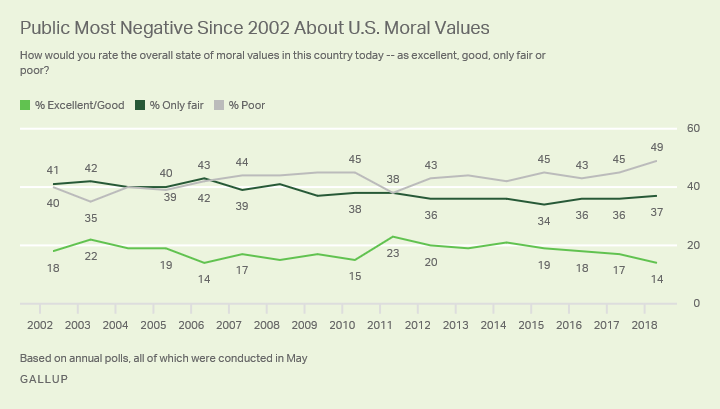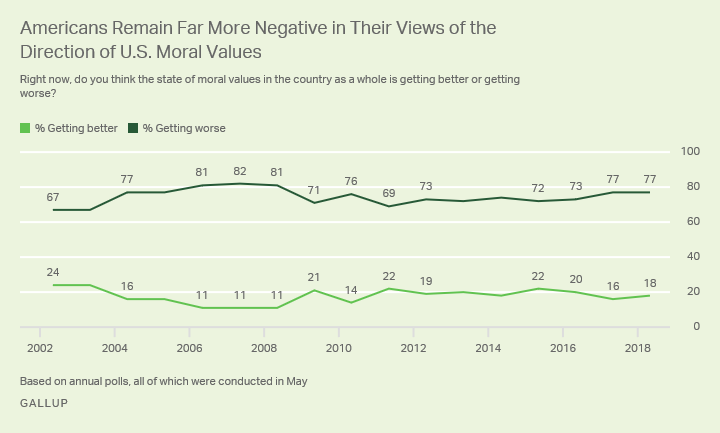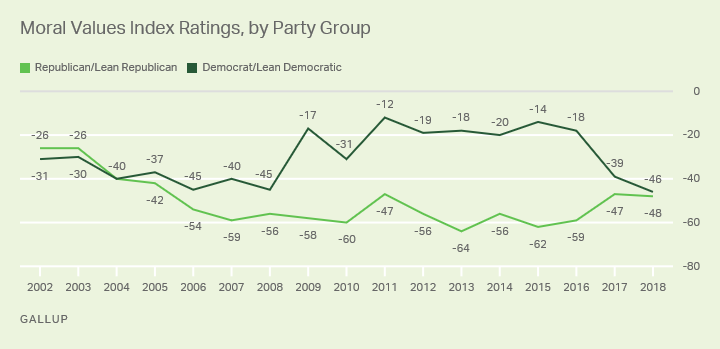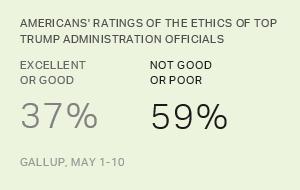Story Highlights
- More than three in four Americans say morals "getting worse"
- Republicans, Democrats now about equally negative on U.S. morals
WASHINGTON, D.C. -- Forty-nine percent of Americans say the state of moral values in the U.S. is "poor" -- the highest percentage in Gallup's trend on this measure since its inception in 2002. Meanwhile, 37% of U.S. adults say moral values are "only fair," and 14% say they are "excellent" or "good."

These data are from Gallup's annual Values and Morals poll, conducted May 1-10.
Americans have always viewed the state of U.S. morals more negatively than positively. But the latest figures are the worst to date, with a record-high 49% rating values as poor and a record-tying-low 14% rating them as excellent or good.
In earlier polls on the measure, Americans were about as likely to rate the country's moral standing as only fair as they were to say it was poor. But in 10 of the past 12 annual polls since 2007, Americans have been decidedly more likely to rate it as poor.
More Than Three in Four Americans Say U.S. Moral Values Are "Getting Worse"
When asked whether U.S. moral values are getting better or worse, Americans have consistently said they are worsening, and that remains the case today. Currently, 77% say moral values in the U.S. are getting worse, while 18% say they are getting better.
Views of the direction of the country's morals were slightly more negative from 2006 to 2008, however, when 81% to 82% said the state of moral values was declining.

Republicans and Democrats Now About Equally Negative on U.S. Moral Values
Gallup computes a moral values index with the two measures, based on the average net positive figures for both questions; the index has a theoretical range of -100 (if everyone thinks morals are poor and getting worse) to +100 (if everyone believes morals are excellent or good and getting better).
Republicans' and Democrats' moral values index scores are currently about equally negative, with Republicans' at -48 and Democrats' at -46. This parity is similar to what Gallup found in its earliest measures from 2002 to 2005. However, from 2006 to 2016, starting in George W. Bush's second term and intensifying during Barack Obama's presidency, Republicans and Republican-leaning independents expressed far more negative views about the nation's moral values than Democrats and Democratic-leaning independents did. This is evident in Republicans' index scores consistently falling below -40 during this period, whereas Democrats' scores moved closer to -20 once Obama became president.
But since President Donald Trump has taken office, Democrats have become more negative in their views of the current state and direction of U.S. values, even as Republicans have become significantly less negative -- moving each group's index score to about the same level: near or above -40. Democrats' and Republicans' index scores on this measure are now the closest they have been since 2004. By one index point, Democrats' latest score is the most negative it has been in Gallup's 16-year trend.

Bottom Line
Americans remain mostly negative in their views about the current state of U.S. moral values, with the percentage who say they are "poor" increasing in recent years so it is now just shy of a majority. While Americans during this time have shifted a great deal toward saying many issues are morally acceptable, the vast majority continue to believe moral values overall are worsening.
Though the question wording makes no reference to politics or the president, Americans seem to rate U.S. moral values through their own partisan lenses -- with both Democrats and Republicans having become less negative after the election of a president of their own party over the past decade.
Survey Methods
Results for this Gallup poll are based on telephone interviews conducted May 1-10, 2018, with a random sample of 1,024 adults, aged 18 and older, living in all 50 U.S. states and the District of Columbia. For results based on the total sample of national adults, the margin of sampling error is ±4 percentage points at the 95% confidence level. All reported margins of sampling error include computed design effects for weighting.
Each sample of national adults includes a minimum quota of 70% cellphone respondents and 30% landline respondents, with additional minimum quotas by time zone within region. Landline and cellular telephone numbers are selected using random-digit-dial methods.
View survey methodology, complete question responses and trends.
Learn more about how the Gallup Poll Social Series works.





